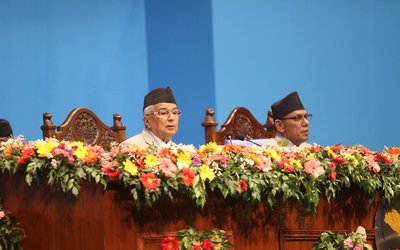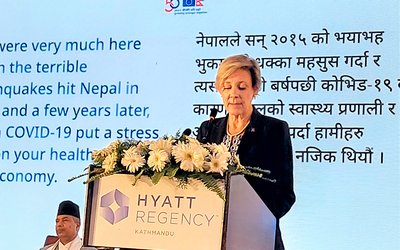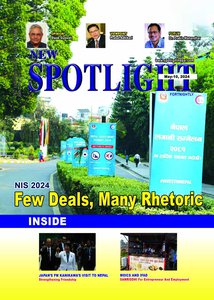
The last American soldier left Afghanistan today – a ghostly, lonely green spectre reminiscent of the painting of the last British soldier allowed to leave Jalalabad in 1842to tell the tale after the British disaster in the Anglo-Afghan war. One wonders what tales the US and NATO soldiers will be telling their neighbours and children back home, what impact this trauma will have on them, and how they will see their own role in the new world order yet to evolve. One wonders what Afghans will be telling themselves too, those that worked with the occupiers and were able to leave the country, those that could not, and – most importantly – the much larger population in the country maimed, displaced or with loved ones that were killed by the occupiers or by those who were opposing them.
We, neighbours of Afghanistan in SAARC, too will have to reflect on these events and what they mean for us, to see things from the larger historical perspective. If anything, unlike the news we have been bombarded with these last few weeks by the Western media and mindlessly regurgitated by our own shallow Sahuji media, Afghanistan is bigger than Kabul airport and much more than the frightened crowd of locals milling about the gates for a chance to be ferried out by the departing occupiers. For the older of those among us, Afghanistan has been in the news and our consciousness for almost five decades, since July 1973 to be exact, when Mohammad Daud Khan (a cousin and brother-in-law of the king) overthrew the monarchy of King Zahir Shah and declared Afghanistan a republic and himself the president.
I still remember that day in Kiev being with fellow hostelites from Afghanistan, all of us students in the former Soviet Union. There wasn't much joy among them on the overthrow of the King, not with the few monarchists obviously but not with the bigger group of communist-leaning among them either. Similar to Nepal, the country is a historically evolved mosaic of at least fourteen major ethnic groups speaking some thirty languages from Indo-European, Turkic and Dravidian families. The only thing that unites them is Islam, but that too is deeply divided first into Sunni and Shia and those further into many more sub-divisions that, similar to other two Abrahamic faiths of Christianity and Judaism, often regard the other sects as apostates destined for Jahannam (hell). Interestingly, although Mahmud of Ghazni set up an 11th Century empire stretching from much of today's Iran to Western India, the country continued to see the practice of Zoroastrianism, Hinduism and Buddhism well into the 19th Century. Only after the Afghan ruler Amir Abdul Rahman Khan conquered the region in 1896 did north-eastern Kafiristan or Nuristan become Muslim.
Modern Afghanistan dates from 1826 (almost half a century after Prithvi Narayan Shah united modern Nepal) when the Barakzai clan emerged on top after years of infighting and Dost Mohammad Khan became the ruler. He managed a deft diplomacy between contending powers, Russians to the north and the British to the east; but the British invaded in 1939, and had him removed to install a more pliant to them Shah Suja on the throne. (Interestingly 'Shah Suja' is an Afghan term for a Quisling or a Mir Jaffar, the Soviet-installed Babrak Karmal referred to as 2nd Shah Suja, and American-installed Hamid Karzai as 3rd Shah Suja. It is similar to Nepalis using the term Lendhup for Sikkim's turncoat). The situation remained in a flux till the end of the 2nd Anglo-Afghan war when the Gandamak Treaty (similar to the Sugauli Treaty imposed on Nepal in 1815) was signed in May 1879 giving the Delhi Viceroy primacy in Afghan affairs, including in international dealings "as per the wishes and advice of the British government".
More internal instabilities followed, with the assassination of the British envoy and Emirs abdicating and new ones succeeding. It was only in 1880 that the boundaries of modern Afghanistan were drawn by agreement between the British and the Russians. And it was only after the British were weakened following World War I that the new Emir Amanullah Khan declared independence from the British. It was promptly followed by the last and only month-long Anglo-Afghan war in August 1919resulting in the Treaty of Rawalpindi recognizing the independence of Afghanistan.
Interestingly, Nepal's Rana Shogun Chandra Sumshere supplied Nepali troops to the British to fight against the Turks, and when the Gallipoli Campaign in the Dardanelles straits was unsuccessful, the British decided to launch the 3rd and last Afghan war, including the use of Nepali troops. One still remembers old Nepali veterans referring to the battles they fought in the 'Phrantey" (Frontiers). Within Afghanistan, Emir Amanullah became the first head-of-state in the world to recognize Lenin's Bolshevik government with whom he signed a friendship treaty before signing the Rawalpindi Treaty with the British. That "special relationship" with the Soviets lasted until December 1979.
It was Daud who set off the current cycle of instability when he overthrew his cousin the King in 1973. Earlier in 1953, he had become a prime minister and introduced many social reforms including allowing women to attend universities and to work. In difficult to comprehend bizarre Byzantine tribal politics, the Afghan communists overthrew and killed Daud in 1978, proclaimed themselves independent of the Soviets and started pursuing nationalistic and Islamic policies. But, as with communists in Nepal, they quickly broke up into factions as conservative and ethnic forces began opposing Daud-introduced social reforms.
In 1979, the American ambassador was killed as was the communist president Taraki. Soviets invaded Afghanistan in 1979 December to bolster his communist successor Babrak Karmal's regime, prompting widespread Afghan opposition to foreign occupation. The Mujahadeen that included Osama bin Laden, backed by Americans, Pakistanis and the Saudi Wahabis, gained ground forcing the Soviets to eventually withdraw by 1989. The Soviet puppet Najibullah was overthrown by the Mujahadeen in 1992 and took refuge in a UN compound. The Mujahadeen in turn fractured, leading to the rise of the Taliban (as well as al-Qaida) who executed Najibullah and hanged his body publicly. In 1998, Bill Clinton initiated cruise missile attacks against suspected al-Qaida bases in Afghanistan for attacks against US embassies in Africa, missed the Saudis but killed many Afghan civilians. Northern Alliance's Masood opposing the Taliban was assassinated two days before 9/11 happened in the US. The rest, as they say, is history.
These are historical facts but what do they mean? To help us think through we have two unconventional historians, mostly ignored in orthodox academia, who give us underlying trends: Arnold Toynbee who sees beyond history of countries to civilizations in conflict, and L.S. Stavrianoswho sees capitalism re-shaping societies as never before in human history.
If one pursued Toynbee's thesis, Afghanistan was the faultline between Syraic (Islamic) and Indic civilizations that, with Western globalization, morphed into one between it and the West. And its 'universal church' Islam too is fractured into many sects, the three primary political contenders being the Saudi Wahabis (backed by the Americans for rather crass capitalist interests), the Iranian Shias and the Pakistani Sunnis with Baathist secular reformist forces further to the West in retreat due to Western onslaught, although regrouping with Russian help. How these forces will play out, and in what permutations, in the years ahead is anyone's guess.
Stavrianos takes an even more panoramic view of global history than Toynbee. He contends that three societies have dominated human history whose memes, the cultural counterpart of genes, find reflection in today's societies as well to varying degrees. They are kinship societies from the dawn of human history till the rise of tributary societies (Toynbee's civilizations) a few thousand years back. Some five hundred years back, capitalist societies arose in Western Europe which is now spread globally and divides the world into colonizers and the colonized, or "Third World-ized". They each successfully met certain basic human needs of their times but soon faced contradictions: in ecology and human surroundings, in gender relations, in broader social relations and in war-conducting capacities which are "Ariadne's threads" that are lifelines from our ancient past.
Just take gender relations, as that is the most pronounced issue about Afghanistan currently and which will shackle the way it will negotiate its future. In kinship societies, women were as much part of the daily production process as men and hence more equal than in later stages. In tributary societies, they were confined to the domestic sphere. However, in capitalist societies, they have been brought out into the factories as labour with traditional household and child-rearing burden only ameliorated to an extent by technology (washing machines, birth control pills, etc.) and only in advanced capitalist societies.
How will kinship and tributary memes still deeply embedded in Afghan culture contend with capitalist revenue needs not only of the Afghan state but also of its collaborators such as Chinese capitalism?How will the future unfold for the four strands of Ariadne's Thread in this crossroad of Asia? Although only time will tell, we can make sensible conjectures that the road ahead will be very rough for Afghanistan and its neighbours.

Dipak Gyawali
Gyawali is Pragya (Academician) of the Nepal Academy of Science and Technology (NAST) and former minister of water resources.
- Unfolding International Disorder & What It Portends For Small Countries
- May 08, 2024
- Maldevelopment And Technology: Ethos Harbingering Coming Apocalypse
- Apr 03, 2024
- World Social Forum: Rethinking and Redefining Development Itself
- Feb 21, 2024
- Remembering An Inspiring Karma Yogi
- Jan 09, 2024
- New World Disorder And The Case For Ideology
- Dec 13, 2023
















